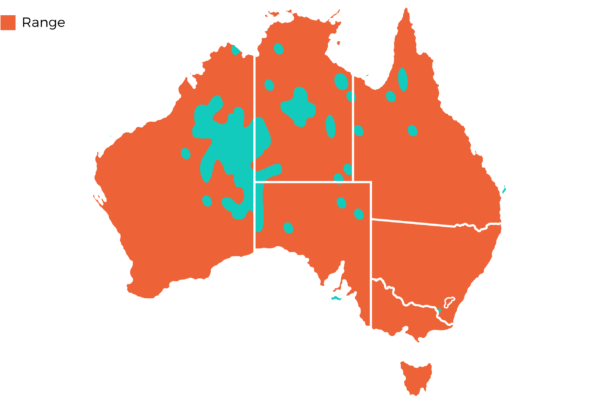Description
The Wedge-Tailed Eagle has long wings (wingspan 2.3 metres), a characteristic long, wedge-shaped tail, and legs that are feathered all the way to the base of the toes. The bill is pale pink to cream, the eye brown to dark brown, and the feet off-white. Young Wedge-Tailed Eagles are mid brown in colour with reddish-brown heads and wings. They become progressively blacker for at least the first ten years of their lives; adults are mostly dark blackish-brown. The only difference in plumage between the sexes is that a female adult is generally slightly paler than her mate.
Distribution
The Wedge-Tailed Eagle is found throughout mainland Australia, Tasmania and southern New Guinea.

Lifespan
20 - 40 years.
Size
The size of the Wedge Tailed Eagle is 87 - 105 centimetres in length and weighs approximately 4 - 5 kgs.
Diet
Wedge-Tailed Eagles eat both live prey and carrion. Their diet reflects the available prey, but the most important live items are rabbits and hares. Rabbits usually make up about 30 - 70% of their diet. Other food items include lizards, birds and mammals.
Habitat
The Wedge-Tailed Eagle is found from sea level to alpine regions in the mountains but prefers wooded and forested land and open country, generally avoiding rainforests and coastal heaths. Eagles can be seen perched on trees or poles or soaring overhead to altitudes of up to 2000 metres.
Breeding
Wedge-Tailed Eagles have monogamous relationships for life; a pair will breed exclusively until one mate dies, upon which the survivor may or may not seek another partner. Established breeding pairs are territorial and live in the one area throughout the year, defending around their nest sites from other Wedge-Tailed Eagles.
Breeding takes place from the months of June to August, though there may be a second occurrence as late as October if the eggs are infertile or captured by a nest predator.
The timing of breeding may vary from location to location and from year to year according to the local availability of food. Both parents share in the duties of nest building, incubation and feeding of the young. A clutch consists of 1 - 3 white eggs with varying amounts of reddish brown spots and blotches. The juveniles remain with the adults for about 11 weeks after leaving the nest.
楔尾鹰 | オナガイヌワシ | 쐐기꼬리수리